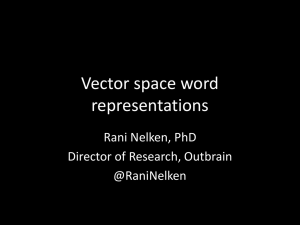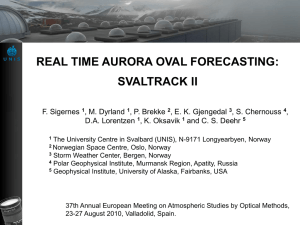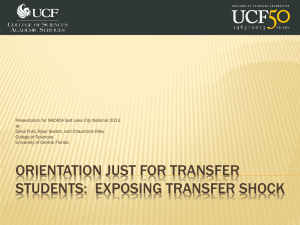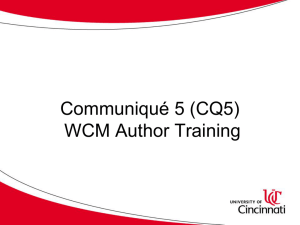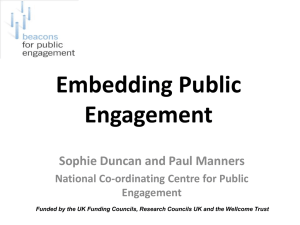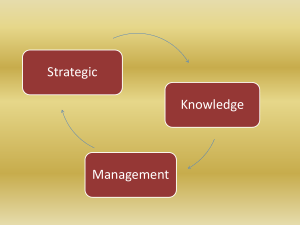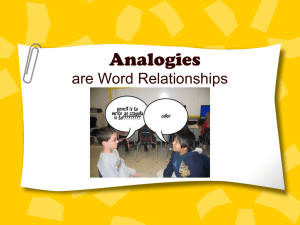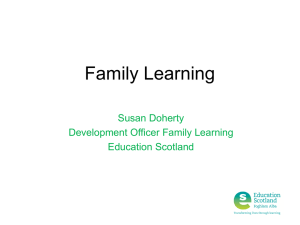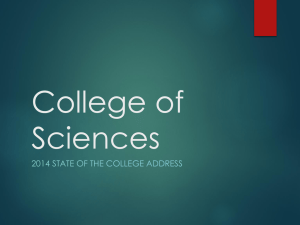2014_acl_goldberg
advertisement
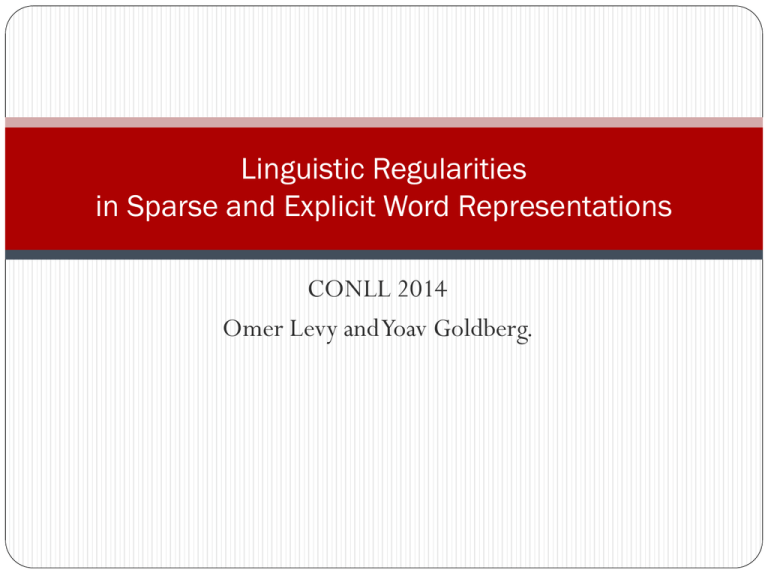
Linguistic Regularities in Sparse and Explicit Word Representations CONLL 2014 Omer Levy and Yoav Goldberg. Astronomers have been able to capture and record the moment when a massive star begins to blow itself apart. International Politics A distance measure between words? 𝑑 𝑤𝑖 , 𝑤𝑗 • Document clustering • Machine translation • Information retrieval • Question answering • …. Space Science Vector representation? Vector Representation Explicit Continuous ~ Embeddings ~ Neural 𝑅𝑢𝑠𝑠𝑖𝑎 is to 𝑀𝑜𝑠𝑐𝑜𝑤 as 𝐽𝑎𝑝𝑎𝑛 is to 𝑇𝑜𝑘𝑦𝑜 Figures from (Mikolov et al.,NAACL, 2013) and (Turian et al., ACL, 2010) Continuous vectors representation • Interesting properties: directional similarity Older continuous vector representations: • Latent Semantic Analysis • Analogy between words: • Latent Dirichlet Allocation (Blei, Ng, Jordan, 2003) • etc. woman − man ≈ queen − king A recent result and Golberg, NIPS, 2014) king −(Levy man + woman ≈ queen mathematically showed that the two representation are “almost” equivalent. Figure from (Mikolov et al.,NAACL, 2013) Goals of the paper • Analogy: 𝑎 is to 𝑎 ∗ as 𝑏 is to 𝑏 ∗ • With simple vector arithmetic: 𝑎 − 𝑎∗ = 𝑏 − 𝑏∗ • Given 3 words: 𝑎 is to 𝑎 ∗ as 𝑏 is to ? • Can we solve analogy problems with explicit representation? • Compare the performance of the • Continuous (neural) representation • Explicit representation Baroni et al. (ACL, 2014) showed that embeddings outperform explicit Explicit representation • Term-Context vector computer data pinch result sugar apricot 0 0 1 0 1 pineapple 0 0 1 0 1 digital 2 1 0 1 0 information 1 6 0 4 0 • 𝐴𝑝𝑟𝑖𝑐𝑜𝑡: 𝐶𝑜𝑚𝑝𝑢𝑡𝑒𝑟: 0, 𝑑𝑎𝑡𝑎: 0, 𝑝𝑖𝑛𝑐ℎ: 1, … ∈ ℝ 𝑉𝑜𝑐𝑎𝑏 ≈100,000 • Sparse! • Pointwise Mutual Information: P ( word , context ) PMI ( word , context ) log 2 P ( word ) P ( context ) • Positive PMI: • Replace the negative PMI values with zero. Continuous vectors representation • Example: 𝐼𝑡𝑎𝑙𝑦: (−7.35, 9.42, 0.88, … ) ∈ ℝ100 • Continuous values and dense • How to create? • Example: Skip-gram model (Mikolov et al., arXiv preprint arXiv:1301.3781) 1 𝐿= 𝑇 𝑇 𝑡=1 −𝑐≤𝑗≤𝑐 log 𝑝(𝑤𝑗+𝑡 |𝑤𝑡 ) 𝑗≠0 exp (𝑣𝑖 . 𝑣𝑗 ) 𝑝 𝑤𝑖 𝑤𝑗 = 𝑘 exp (𝑣𝑖 . 𝑣𝑘 ) • Problem: The denominator is of size 𝑘. • Hard to calculate the gradient Formulating analogy objective • Given 3 words: 𝑎 is to 𝑎∗ as 𝑏 is to ? • Cosine similarity: • Prediction: 𝑎. 𝑏 cos 𝑎, 𝑏 = 𝑎 𝑏 arg max cos 𝑏 ∗ , 𝑏 − 𝑎 + 𝑎∗ ∗ 𝑏 • If using normalized vectors: ∗ , 𝑏 − cos 𝑏 ∗ , 𝑎 + cos 𝑏 ∗ , 𝑎 ∗ arg max cos 𝑏 ∗ 𝑏 • Alternative? • Instead of adding similarities, multiply them! cos 𝑏 ∗ , 𝑏 cos 𝑏 ∗ , 𝑎∗ arg max 𝑏∗ cos 𝑏 ∗ , 𝑎 Corpora • MSR: • Google: ~8000 syntactic analogies ~19,000 syntactic and semantic analogies a b a* b* Good Better Rough ? better good rougher ? good best rough ? … … … … • Learn different representations from the same corpus: Very important!! Recent controversies over inaccurate evaluations for “GloVe wordrepresentation” (Pennington et al, EMNLP) Embedding vs Explicit (Round 1) 70% 60% Accuracy 50% 40% 30% Embedding 63% Embedding 54% 20% Explicit 29% 10% Explicit 45% 0% MSR Google Many analogies recovered by explicit, but many more by embedding. Using multiplicative form • Given 3 words: 𝑎 is to 𝑎∗ as 𝑏 is to ? • Cosine similarity: 𝑎. 𝑏 cos 𝑎, 𝑏 = 𝑎 𝑏 • Additive objective: arg max cos 𝑏 ∗ , 𝑏 − cos 𝑏 ∗ , 𝑎 + cos 𝑏 ∗ , 𝑎∗ ∗ 𝑏 • Multiplicative objective: cos 𝑏 ∗ , 𝑏 cos 𝑏 ∗ , 𝑎∗ arg max 𝑏∗ cos 𝑏 ∗ , 𝑎 A relatively weak justification England − London + Baghdad = ? Iraq cos 𝐼𝑟𝑎𝑞, 𝐸𝑛𝑔𝑙𝑎𝑛𝑑 − cos 𝐼𝑟𝑎𝑞, 𝐿𝑜𝑛𝑑𝑜𝑛 + cos 𝐼𝑟𝑎𝑞, 𝐵𝑎𝑔ℎ𝑑𝑎𝑑 0.15 0.13 0.63 0.13 0.14 0.75 cos 𝑀𝑜𝑠𝑢𝑙, 𝐸𝑛𝑔𝑙𝑎𝑛𝑑 − cos 𝑀𝑜𝑠𝑢𝑙, 𝐿𝑜𝑛𝑑𝑜𝑛 + cos 𝑀𝑜𝑠𝑢𝑙, 𝐵𝑎𝑔ℎ𝑑𝑎𝑑 Embedding vs Explicit (Round 2) 80% 70% Accuracy 60% 50% 40% 30% 20% Add 54% Mul 59% Add 63% Mul 67% Mul 68% Mul 57% Add 45% Add 29% 10% 0% MSR Google Embedding MSR Google Explicit 80% 70% Accuracy 60% 50% 40% 30% Embedding 59% Explicit 57% Embedding 67% 20% 10% 0% MSR Google Explicit 68% Summary • On analogies, continuous (neural) representation is not magical • Analogies are possible in the explicit representation • On analogies explicit representation can be as good as continuous (neural) representation. • Objective (function) matters! Agreement between representations Objective Both Correct Both Wrong Embedding Correct Explicit Correct MSR 43.97% 28.06% 15.12% 12.85% Google 57.12% 22.17% 9.59% 11.12% Comparison of objectives Objective Additive Multiplicative Representation MSR Google Embedding Explicit Embedding Explicit 53.98% 29.04% 59.09% 56.83% 62.70% 45.05% 66.72% 68.24% Recurrent Neural Network • Recurrent Neural Networks (Mikolov et al.,NAACL, 2013) • Input-output relations: 𝑦 𝑡 = 𝒈(𝑽𝑠 𝑡 ) 𝑠 𝑡 = 𝑓(𝑾𝑠 𝑡 − 1 + 𝑼𝑤(𝑡)) • 𝑦 ∈ ℝ 𝑉𝑜𝑐𝑎𝑏 • 𝑤 𝑡 ∈ ℝ 𝑉𝑜𝑐𝑎𝑏 • 𝑠 𝑡 ∈ ℝ𝑑 • 𝑼 ∈ ℝ|𝑉𝑜𝑐𝑎𝑏|×𝑑 • 𝑾 ∈ ℝ𝑑×𝑑 • 𝑽 ∈ ℝ𝑑×|𝑉𝑜𝑐𝑎𝑏| Continuous vectors representation • Example: 𝐼𝑡𝑎𝑙𝑦: (−7.35, 9.42, 0.88, … ) ∈ ℝ100 • Continuous values and dense • How to create? • Example: Skip-gram model (Mikolov et al., arXiv preprint arXiv:1301.3781) 1 𝐿= 𝑇 𝑇 𝑡=1 −𝑐≤𝑗≤𝑐 log 𝑝(𝑤𝑗+𝑡 |𝑤𝑡 ) 𝑗≠0 exp (𝑣𝑖 . 𝑣𝑗 ) 𝑝 𝑤𝑖 𝑤𝑗 = 𝑘 exp (𝑣𝑖 . 𝑣𝑘 ) • Problem: The denominator is of size 𝑘. • Hard to calculate the gradient Continuous vectors representation 1 𝐿= 𝑇 𝑇 𝑡=1 −𝑐≤𝑗≤𝑐 log 𝑝(𝑤𝑗+𝑡 |𝑤𝑡 ) 𝑗≠0 exp (𝑣𝑖 . 𝑣𝑗 ) 𝑝 𝑤𝑖 𝑤𝑗 = 𝑘 exp (𝑣𝑖 . 𝑣𝑘 ) • Problem: The denominator is of size 𝑘. • Hard to calculate the gradient • Change the objective: 1 𝑝 𝑤𝑖 𝑤𝑗 = 1 + exp (𝑣𝑖 . 𝑣𝑗 ) • Has trivial solution! • Introduce artificial negative instances! 𝐿𝑖𝑗 = log 𝜎(𝑣𝑖 . 𝑣𝑗 ) + 𝑘𝑙=1 𝐸𝑤𝑙 ∼𝑃𝑛 𝑤 [log 𝜎(−𝑣𝑙 . 𝑣𝑗 )] References Slides from: http://levyomer.wordpress.com/2014/04/25/linguistic-regularities-in-sparse-andexplicit-word-representations/ Mikolov, Tomas, et al. "Distributed representations of words and phrases and their compositionality." Advances in Neural Information Processing Systems. 2013. Mikolov, Tomas, Wen-tau Yih, and Geoffrey Zweig. "Linguistic Regularities in Continuous Space Word Representations." HLT-NAACL. 2013.
